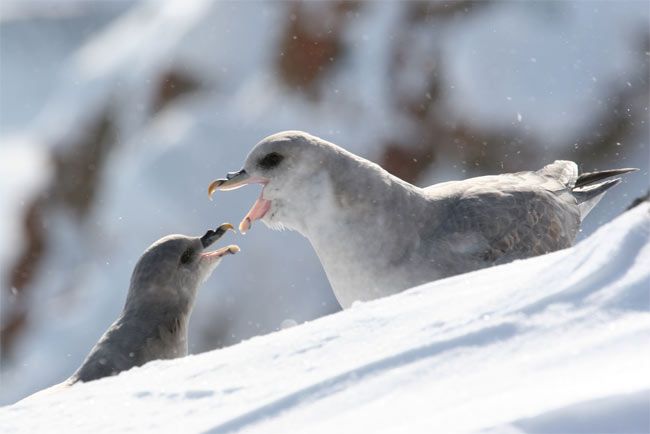Strange Bird Deaths Create Arctic Tragicomedy

Like scenes out of Gary Larson's "Far Side" comic strip, scientists have discovered a tragicomedy playing out in deaths of Arctic seabirds.
Some crash into each other in heavy fog. Others perish when heavy winds slam them into cliffs. Still others simply bleed to death after being attacked by mosquito swarms.
"We saw birds dying of what at best could be called Gary Larson events," said Mark Mallory of the Canadian Wildlife Service in Iqaluit. "You see a bird for apparently no good reason fly into the cliff and die. You've got to be kidding."
Mallory and two other Canadian scientists reviewed 33 years and 7,000 days of fieldwork that had observed six bird species in 11 different colonies in the eastern Arctic ranging from northern Hudson Bay to Devon Island. The findings were published recently in the journal Arctic.
Strange episodes
More than 20 Northern fulmars were caught in an avalanche slide and died hitting the sea ice. The fulmars, like other Arctic seabirds, tend to nest on cliffs made of sedimentary rock, which erodes more easily than other rock types. Early in the summer season, as the weather is just warming up and the ice and snow start to melt, there are small avalanches.
In another slapstick, albeit sad, event, a thick-billed murre was found dead after getting its foot stuck in a crack in the cliff face on Coats Island.
Sign up for the Live Science daily newsletter now
Get the world’s most fascinating discoveries delivered straight to your inbox.
In July 2005 at Lancaster Sound, hundreds of thick-billed murres (birds that resemble penguins but can fly) and black-legged kittiwakes died where they were nesting: "An entire cliff face fell away, and we estimate 800 birds were killed in this one event," Mallory told LiveScience, adding that his colleague said it looked as if the rock had liquefied and the birds were just caught in the rubble.
The researchers suspect as the ice goes through freezing and melting, and the consequential expanding and contracting, it puts pressure on the rocks and causes these rock falls.
Broken wings also took the lives of some savvy flyers.
"I was working at a fulmar colony and after a couple of days of fog we'd see fulmars on the sea ice, alive but with their wings broken," Mallory said. "These birds are phenomenal flyers, but you take away their visibility to a meter or two and maybe that causes problems. In talking to my Inuit guides, they told me that they had seen this a lot, and thought that the birds flew into each other in low visibility."
Birds were also found dead after being slammed into the ocean from so-called Katabatic winds.
"They flow down off of the glacier with the temperature differential and shoot across the land," Mallory explained. Since the winds are intermittent and the birds, when on land, stay close to cliffs, they go about their usual leap into the ocean to snag food. No matter how much flapping the birds did, Mallory said, they just get driven into the water.
Possibly the most grisly deaths occurred when mosquitoes, which increase in numbers when temperatures warm, attacked the birds' feet.
"It honestly looks like the murre has fur on its feet or is wearing fur slippers," Mallory said.
The researchers note that despite the strange endings, the percentage of dead birds was relatively low — just a few thousands out of millions of birds in the area.
Just getting warmed up
Until now, scientists hadn't taken a close look at how birds living along harsh Arctic shores met their demise, as most studies have focused on the temperate and tropical birds, which tend to die of more "normal" causes, from parasites to oil spills to lack of fish for food.
Mallory's team didn't go into new the study looking for climate-change-related deaths, but that's what they found.
"Curiously a high proportion of the adult birds we see die tend to be dying [due] to factors related to climate and weather," Mallory said. Some birds were killed by erosion of their cliff nests, crushed by melting ice, crushed by avalanches, or slammed into the ocean by really strong winds.
If temperatures warm and intense storms in the Arctic increase, along with other climate factors, "we might see mortality in these birds from these things increase from what they are now." But Mallory adds that he and his team are not sounding an alarm bell that climate change is going to kill off all of the seabirds.
Anthony Gaston and H. Grant Gilchrist of the National Wildlife Research Center in Canada contributed to the research.
- Amazing Animal Abilities
- Top 10 Most Incredible Animal Journeys
- North vs. South Pole: 10 Wild Differences
Jeanna Bryner is managing editor of Scientific American. Previously she was editor in chief of Live Science and, prior to that, an editor at Scholastic's Science World magazine. Bryner has an English degree from Salisbury University, a master's degree in biogeochemistry and environmental sciences from the University of Maryland and a graduate science journalism degree from New York University. She has worked as a biologist in Florida, where she monitored wetlands and did field surveys for endangered species, including the gorgeous Florida Scrub Jay. She also received an ocean sciences journalism fellowship from the Woods Hole Oceanographic Institution. She is a firm believer that science is for everyone and that just about everything can be viewed through the lens of science.













